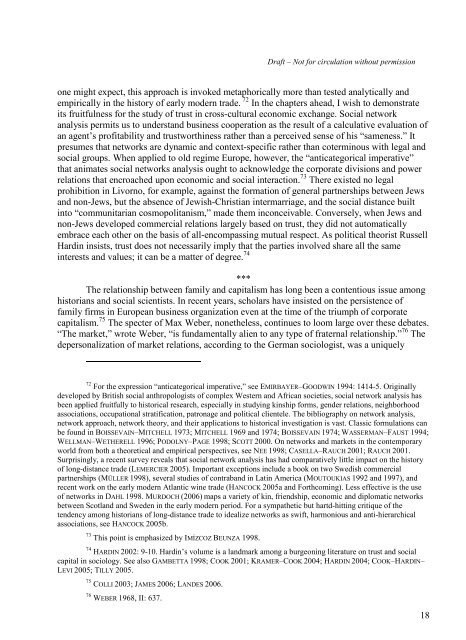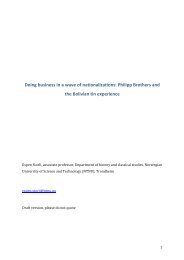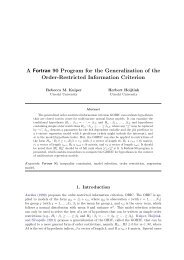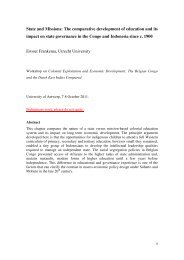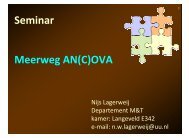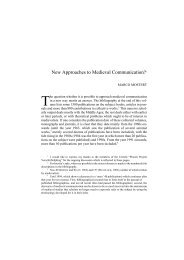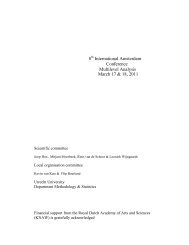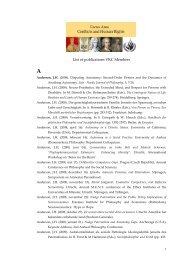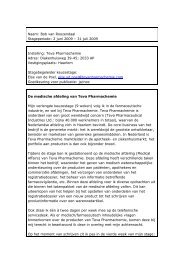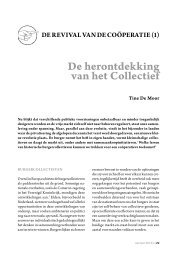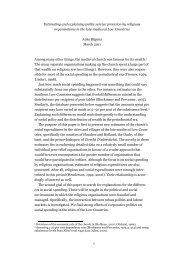Family Structure and Business Organization: Sephardic ... - Partner
Family Structure and Business Organization: Sephardic ... - Partner
Family Structure and Business Organization: Sephardic ... - Partner
Create successful ePaper yourself
Turn your PDF publications into a flip-book with our unique Google optimized e-Paper software.
Draft – Not for circulation without permission<br />
one might expect, this approach is invoked metaphorically more than tested analytically <strong>and</strong><br />
empirically in the history of early modern trade. 72 In the chapters ahead, I wish to demonstrate<br />
its fruitfulness for the study of trust in cross-cultural economic exchange. Social network<br />
analysis permits us to underst<strong>and</strong> business cooperation as the result of a calculative evaluation of<br />
an agent’s profitability <strong>and</strong> trustworthiness rather than a perceived sense of his “sameness.” It<br />
presumes that networks are dynamic <strong>and</strong> context-specific rather than coterminous with legal <strong>and</strong><br />
social groups. When applied to old regime Europe, however, the “anticategorical imperative”<br />
that animates social networks analysis ought to acknowledge the corporate divisions <strong>and</strong> power<br />
relations that encroached upon economic <strong>and</strong> social interaction. 73 There existed no legal<br />
prohibition in Livorno, for example, against the formation of general partnerships between Jews<br />
<strong>and</strong> non-Jews, but the absence of Jewish-Christian intermarriage, <strong>and</strong> the social distance built<br />
into “communitarian cosmopolitanism,” made them inconceivable. Conversely, when Jews <strong>and</strong><br />
non-Jews developed commercial relations largely based on trust, they did not automatically<br />
embrace each other on the basis of all-encompassing mutual respect. As political theorist Russell<br />
Hardin insists, trust does not necessarily imply that the parties involved share all the same<br />
interests <strong>and</strong> values; it can be a matter of degree. 74<br />
***<br />
The relationship between family <strong>and</strong> capitalism has long been a contentious issue among<br />
historians <strong>and</strong> social scientists. In recent years, scholars have insisted on the persistence of<br />
family firms in European business organization even at the time of the triumph of corporate<br />
capitalism. 75 The specter of Max Weber, nonetheless, continues to loom large over these debates.<br />
“The market,” wrote Weber, “is fundamentally alien to any type of fraternal relationship.” 76 The<br />
depersonalization of market relations, according to the German sociologist, was a uniquely<br />
72 For the expression “anticategorical imperative,” see EMIRBAYER–GOODWIN 1994: 1414-5. Originally<br />
developed by British social anthropologists of complex Western <strong>and</strong> African societies, social network analysis has<br />
been applied fruitfully to historical research, especially in studying kinship forms, gender relations, neighborhood<br />
associations, occupational stratification, patronage <strong>and</strong> political clientele. The bibliography on network analysis,<br />
network approach, network theory, <strong>and</strong> their applications to historical investigation is vast. Classic formulations can<br />
be found in BOISSEVAIN–MITCHELL 1973; MITCHELL 1969 <strong>and</strong> 1974; BOISSEVAIN 1974; WASSERMAN–FAUST 1994;<br />
WELLMAN–WETHERELL 1996; PODOLNY–PAGE 1998; SCOTT 2000. On networks <strong>and</strong> markets in the contemporary<br />
world from both a theoretical <strong>and</strong> empirical perspectives, see NEE 1998; CASELLA–RAUCH 2001; RAUCH 2001.<br />
Surprisingly, a recent survey reveals that social network analysis has had comparatively little impact on the history<br />
of long-distance trade (LEMERCIER 2005). Important exceptions include a book on two Swedish commercial<br />
partnerships (MÜLLER 1998), several studies of contrab<strong>and</strong> in Latin America (MOUTOUKIAS 1992 <strong>and</strong> 1997), <strong>and</strong><br />
recent work on the early modern Atlantic wine trade (HANCOCK 2005a <strong>and</strong> Forthcoming). Less effective is the use<br />
of networks in DAHL 1998. MURDOCH (2006) maps a variety of kin, friendship, economic <strong>and</strong> diplomatic networks<br />
between Scotl<strong>and</strong> <strong>and</strong> Sweden in the early modern period. For a sympathetic but hartd-hitting critique of the<br />
tendency among historians of long-distance trade to idealize networks as swift, harmonious <strong>and</strong> anti-hierarchical<br />
associations, see HANCOCK 2005b.<br />
73 This point is emphasized by IMÍZCOZ BEUNZA 1998.<br />
74 HARDIN 2002: 9-10. Hardin’s volume is a l<strong>and</strong>mark among a burgeoning literature on trust <strong>and</strong> social<br />
capital in sociology. See also GAMBETTA 1998; COOK 2001; KRAMER–COOK 2004; HARDIN 2004; COOK–HARDIN–<br />
LEVI 2005; TILLY 2005.<br />
75 COLLI 2003; JAMES 2006; LANDES 2006.<br />
76 WEBER 1968, II: 637.<br />
18


